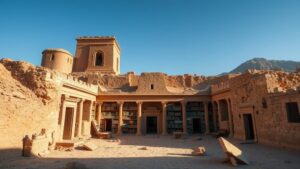Investigating the “Canyon of the Singing Waters,” where an ancient city’s ruins echo with mysterious sounds.
Investigation of the Canyon of the Singing Waters
Nestled deep within the Andes of Peru, the Canyon of the Singing Waters has captivated adventurers and researchers alike with its eerie yet enchanting acoustics. This remote canyon, located near the ancient city of Vilcabamba, is steeped in mystery and legend, drawing explorers who seek to uncover the secrets that echo through its ruins. The combination of natural acoustics and historical remnants paints a vivid picture of a civilization long past.
The Ruins of Vilcabamba
Vilcabamba, often referred to as the last stronghold of the Inca Empire, is located approximately 70 kilometers from the city of Cusco. This site was a significant area for the Incas following their retreat from the Spanish conquistadors in the 16th century. Archaeological studies have revealed that the city flourished between the 1530s and the 1570s, featuring temples, agricultural terraces, and residential structures, all of which now lay in ruins.
The ruins depict a high degree of architectural sophistication, showcasing dry-stone construction techniques that have withstood the test of time. The most notable feature of Vilcabamba is its array of acoustic phenomena that have led to its current name. Researchers have noted how the unique geography of the canyon amplifies natural sounds, producing an otherworldly auditory experience.
Sound Phenomena in the Canyon
The singing of the canyon is attributed to several natural factors. The canyons walls are composed of sedimentary rock, which reflects sound waves efficiently. Weather conditions, like strong winds or rain, also contribute to the auditory experience. As water flows through the canyon, it creates a melodic echo that can be both soothing and haunting.
In essence, the merging of water flow with the canyons structure creates a natural symphony. The phenomenon is similar to how a violins body amplifies sound; the canyon acts as an acoustic chamber, enhancing the natural frequencies of the environment.
Scientific Investigation
Studies conducted by acoustic scientists and archaeologists have aimed to uncover the source and nature of the sounds emanating from the canyon. One intriguing study in 2020 utilized advanced sound recording technology to document the various acoustic signatures present in the canyon over different seasons.
- The results showed a notable increase in reverberation times during rainy seasons, suggesting that water plays a significant role in the canyons soundscape.
- Researchers have also found that certain frequencies resonate more strongly in particular sections of the canyon, creating a dynamic auditory experience that changes with the landscape.
Also, studies have indicated that these sound phenomena may have had cultural significance for the native inhabitants. It is theorized that the acoustics were used for communication, ritualistic purposes, and perhaps as a means to signal across the vast landscapes.
Historical Context and Cultural Significance
The connection between ancient civilizations and their environment is of paramount interest to archaeologists. The Incas were known for their intricate relationship with nature, often interpreting natural phenomena as spiritual messages. The sounds of the canyon might have been regarded as messages from the gods or the spirits of the ancestors, thus adding to the cultural richness of Vilcabamba.
In contemporary times, the canyon has become a pilgrimage site for those interested in spirituality, history, and acoustics. Today, visitors are encouraged to walk the ruins and listen closely to the symphonies produced by nature, fostering a deep connection to the past.
Conclusion and Future Research
The Canyon of the Singing Waters serves as a profound example of the interplay between nature, sound, and culture. While much has been discovered, there remain untapped potentials within this enigmatic location. Further interdisciplinary research combining archaeology, acoustics, and anthropology could unveil new insights into how ancient civilizations interacted with their acoustic environments.
Explorers and researchers are urged to approach this remarkable site with respect, ensuring that the sounds of the canyon continue to echo through generations as a living testament to an ancient culture that harmonized with its surroundings.
In summary, the Canyon of the Singing Waters is a captivating blend of history, science, and spirituality. As we probe deeper into its mysteries, we not only learn about the past but also gain insights that are relevant to our understanding of nature and our place within it.



